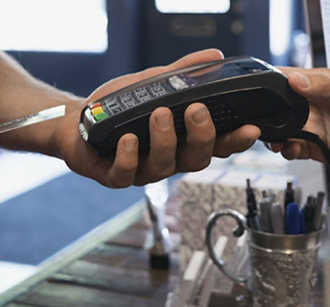
Timeline: The History of the Credit Card
Have you ever asked yourself, “How do credit card payments work – and from where did this technology come?”
In fact, what exactly is a credit card? Below is a visual credit card history that highlights some of the milestones over the years.
Early 1920s
Merchants start extending credit to favored customers with many oil companies providing “courtesy” cards to help drivers pay for petrol at company-owned gas stations. Customers are billed at the end of every month and must pay the total amount to retain usage rights.1
Year 1928
The Charga-Plate is developed. Large scale merchants begin to issue these to customers to use as a store credit cards.2 However, the Charga-Plate’s history is short-lived as newer and more convenient payment options come into the picture.
Year 1946
A Brooklyn banker, John Biggins, partners with local merchants to launch a “Charg-It” card and offers it exclusively to banking customers. Bills have to be settled every month.3
Year 1950
The Diner’s Club® card is introduced as a charge card for travel and entertainment expenses. Within one year, 42,000 consumers become cardholders.4
Year 1958
Credit card history takes a sharp turn when Bank of America launches the “BankAmericard." Unlike with Charga-Plate, Diner’s Club, or Charg-It, this is the first revolving credit product issued by a third-party bank. BankAmericard charges consumers a nominal fee to carry balances over from month-to-month.5
Year 1959
The American Express® Card, which debuts a year earlier, is the first to switch from paper to plastic. AmEx quickly gains international acceptance. 6 By the end of 1962, there are over 900,000 cardholders.7
Year 1966
A group of California banks form the Interbank Card Association (ICA). ICA introduces Mastercard, the second major bank-issued card.8
Year 1971
First Data is founded in Omaha, Nebraska, providing processing services to the Mid-America Bankcard Association (MABA).10
Year 1976
International partnerships and licensing agreements spur the decision to change the BankAmericard name to Visa.9
Year 1976
First Data becomes the first processor of Visa and Mastercard bank-issued credit cards.11
Year 1980
American Express buys 80% of First Data Resources, with the remaining 20% being purchased in 5% increments each subsequent year until June 1983.12
Year 2014
Apple® launches Apple Pay™.13
Year 2015
EMV® liability shift goes into effect in the United States, meaning merchants that don't accept chip cards can now be held responsible for fraudulent in-person credit transactions. Previously, onlycard issuers were liable.14
Today
Now, 75.7%, of U.S. consumers own at least one credit card and the numbers are increasing, with 10 million new consumer cards issued in 2016.15
Credit Card Design and the Evolution of Data Security
Initially, credit cards only featured logos of the issuing bank and card network, plus each user’s:
- Cardholder name
- Account number
- Card expiration date
Over the years, however, additional features have been created to improve the transaction process, help combat fraud, and streamline how credit card payments work.
1969: Magnetic Strip Embedded with cardholder information, magnetic stripes enabled merchants to swipe customers’ cards and increase the speed of each transaction.16
1997: CVV Code (Card verification value). Three- or four-digit codes were added to the back of cards (or front of American Express) to combat Card-Not-Present (CNP) fraud resulting from the growing popularity of online shopping.17
2004: EMV Chip. As fraudsters found avenues to steal payment data and create counterfeit cards, Europay®, Visa, and Mastercard joined forces to introduce the EMV chip as an additional security feature. Today, almost every credit and debit card in America is embedded with an EMV chip.18 (Learn more about EMV.)
The Mechanics of Accepting Card Payments
How Do Credit Card Payments Work?
Below is a brief overview of how credit card payments work – step by step.
Step 1
A cardholder swipes or inserts his or her credit card into a payment terminal to transfer payment information into the merchant’s in-store POS system.
For eCommerce transactions, the cardholder either:
- Enters this data manually at checkout
- Confirms a stored payment option
Step 2
The cardholder’s information is sent electronically to the merchant’s acquiring bank or payment processor (such as First Data). This payment information is then routed to one of the card networks below:
- Visa
- Mastercard
- Discover
- American Express
eCommerce payments also require a “gateway” provider whose role is to connect the merchant’s website to the acquirer.
Step 3
The card network forwards the transaction to the issuing bank to confirm the card’s validity and ensure it hasn’t been reported lost or stolen. The bank also verifies whether the cardholder has sufficient credit to cover the transaction.
Step 4
If the transaction is approved, the issuing bank generates an authorization number and routes it back to the card network. This confirmation signifies the bank is willing to fund the purchase on behalf of the cardholder.
Step 5
The card network forwards the authorization number back to the acquiring bank or payments processor. This number is then forwarded to the merchant, which finalizes the transaction with the customer.
Sources
1 “The History of the Credit Card,” NerdWallet, 10 February 2017
2 “Charga-Plate in Red Leather Case, United States, 1950's,” National Museum of American History
3 “Who Invented the First Bank-Issued Credit Card?” CardRates.com, 24 May 2018
4 “History,” Diners Club International
5 “Introducing the Modern Credit Card from Bank of America,” About Bank of America, 13 August 2014
6 “The Evolution of the Credit Card: From Paper to Plastic to Virtual,” Relatively Interesting
7 “American Express Company,” The Columbia Encyclopedia, 6th Ed, 2018
8 “We've Been Making History for 50 Years,” Mastercard History & Key Milestones
9 “Visa: A Short History,” CreditCards.com, 30 March 2007
10, 11, 12 “History,” First Data
13 “Apple Announces Apple Pay,” Apple, 31 August 2018
14 “EMV Arrived on October 1, 2015. But It's Not Too Late to Adopt EMV Technology,” First Data
15 “Credit Card Ownership Statistics,” CreditCards.com, 26 April 2018
16 “Magnetic Stripe Technology,” IBM Corporation
17 “Can Credit Card Security Codes Sufficiently Protect Against Fraud?” Chargebacks911, 23 May 2018
18 “EMV Roots Go Deep in Europe,” Bank Information Security, 7 March 2011





